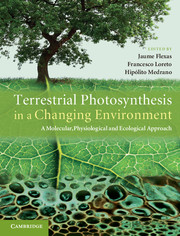 Terrestrial Photosynthesis in a Changing Environment
Terrestrial Photosynthesis in a Changing Environment Book contents
- Frontmatter
- Contents
- List of contributors
- Preface
- Acknowledgements
- List of abbreviations
- 1 Terrestrial photosynthesis in a changing environment
- Part I Photosynthesis
- 2 Biochemistry and photochemistry of terrestrial photosynthesis: a synopsis
- 3 Photosynthetic regulation
- 4 Interactions between photosynthesis and day respiration
- 5 The ecophysiology and global biology of C4 photosynthesis
- 6 Ecophysiology of CAM photosynthesis
- 7 Special photosynthetic adaptations
- 8 Models of photosynthesis
- Part II Measuring photosynthesis
- Part III Photosynthetic response to single environmental factors
- Part IV Photosynthesis in time
- Part V Photosynthesis in space
- Part VI Photosynthesis in a global context
- References
- Index
2 - Biochemistry and photochemistry of terrestrial photosynthesis: a synopsis
Published online by Cambridge University Press: 05 March 2013
- Frontmatter
- Contents
- List of contributors
- Preface
- Acknowledgements
- List of abbreviations
- 1 Terrestrial photosynthesis in a changing environment
- Part I Photosynthesis
- 2 Biochemistry and photochemistry of terrestrial photosynthesis: a synopsis
- 3 Photosynthetic regulation
- 4 Interactions between photosynthesis and day respiration
- 5 The ecophysiology and global biology of C4 photosynthesis
- 6 Ecophysiology of CAM photosynthesis
- 7 Special photosynthetic adaptations
- 8 Models of photosynthesis
- Part II Measuring photosynthesis
- Part III Photosynthetic response to single environmental factors
- Part IV Photosynthesis in time
- Part V Photosynthesis in space
- Part VI Photosynthesis in a global context
- References
- Index
Summary
Introduction
Photosynthesis is typically understood as the light-dependent production of sugar from carbon dioxide (CO2). The endosymbiotic chloroplast is the cellular location for most of this metabolism in plants, but some additional metabolism occurs in the cytosol to make the sugars that will be transported around the plant, mainly sucrose and also sugar alcohols, such as sorbitol and manitol. There are many processes that can properly be called photosynthesis, but a core set of processes underlie most of the considerations in this book. This chapter will provide an overview of those processes, and many topics covered in this chapter are the subject of more in-depth chapters later on. This chapter begins by describing the initial capture and temporary storage of light energy as highly reactive molecules (nicotinamide adenine dinucleotide phosphate (NADPH) and adenosine triphosphate (ATP)) on carbon. By reducing (i.e., by adding electrons to) carbon from its most oxidised state (CO2) to the status of sugars (CH2O)n, the energy initially stored as NADPH and ATP can be stored on the carbon. Additional energy can be stored on each carbon atom by reducing it fully, as happens in the synthesis of oils (R-CH2-R), but this is generally not considered when describing photosynthesis. Finally, issues surrounding uptake of the CO2 will be addressed.
Photochemistry Synopsis
Photochemistry, the capture of light energy and its conversion to chemical energy suitable for reducing CO2 to sugar, is the source of nearly all energy available to living things. Energy captured by absorbing molecules is stored as the high-energy intermediates NADPH (reducing power) and ATP (sometimes called the energy currency of the cell).
- Type
- Chapter
- Information
- Terrestrial Photosynthesis in a Changing EnvironmentA Molecular, Physiological, and Ecological Approach, pp. 9 - 19Publisher: Cambridge University PressPrint publication year: 2012


